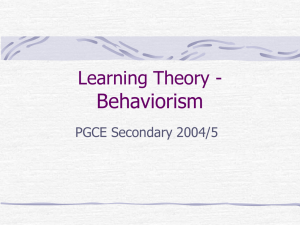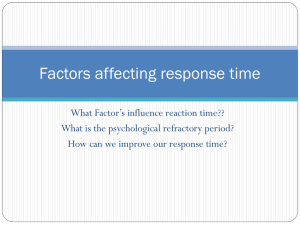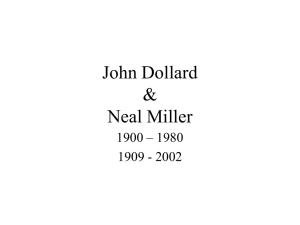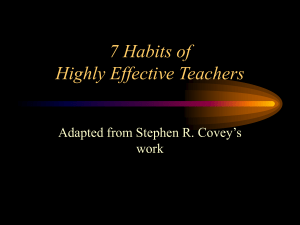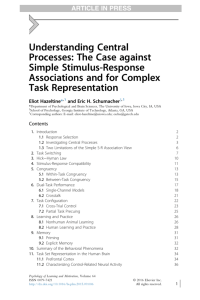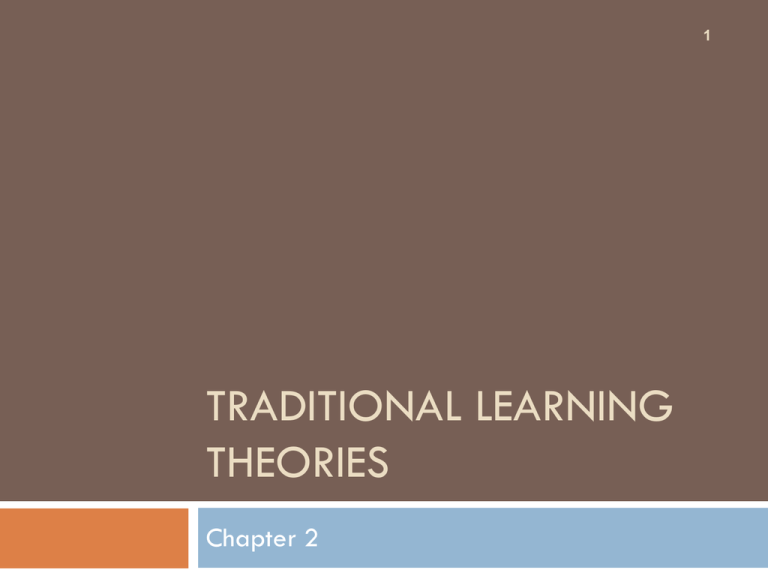
1
TRADITIONAL LEARNING
THEORIES
Chapter 2
Traditional Learning Theories
2
Two major theoretical approaches
S-R
(stimulus-response) theories state that learning
occurs through the association of environmental stimuli
S-S (stimulus-stimulus) theories state that learning
involves recognizing when important events are likely to
occur and understanding how to obtain these events
Anti-theoretical (methodological)
S-R versus S-S Theories
3
S-R theorists (Behaviorist)
inflexible view of behavior
stimulus environment controls behavior
very machine-like
S-S theorists (Cognitive)
somewhat flexible
internal processes control behavior
learn relationships which guides behavior
Types of S-R theories
4
Reinforcement is necessary to learn an S-R association
(Reinforcement)
Thorndike’s law-of-effect proposed that reinforcement
was a necessity
Also, Hull’s S-R theory of learning was the culmination
of this line of thinking
Reinforcement is not necessary to learn an S-R
association (Contiguity)
Guthrie
Hull’s Reinforcement Theory
5
Proposed that primary drives (e.g., hunger, thirst)
are produced by states of deprivation
We
have biological needs and corresponding
psychological drives
we
have a biological need for water that is accompanied by
a psychological drive called thirst
7
Theorized that drive motivates behavior
Drive reduction restores homeostasis
By restoring homeostasis, drive reduction leads to
S-R associative learning
8
Excitatory potential reflects the likelihood that a
specific event (S) will cause the occurrence of a
specific behavior (R).
(S)
S ER
(R)
9
Hull believed that the intensity of instrumental
activity is determined by the combined influence of
several factors
Drive
(D), e.g., vampire thirst
Incentive (K), e.g., amount of blood reward
Habit strength (H), # of previously rewarded leverpresses
Inhibition (I), # of previously unrewarded rewarded
lever-presses
Hull’s Formula:
10
S ER
= drive (D) * incentive (K) * habit (H) – inhibition (I)
SHR
SIR
11
Excitatory potential is determined by:
Drive
(D), the internal arousal state produced by
deprivation (appetitive) or stimulation (aversive) , or
stimuli associated with deprivation or stimulation.
Incentive motivation (K), the internal arousal produced
by the reinforcer (e.g., it’s magnitude)
Habit strength (H), the strength of the connection
between the stimulus and response.
Inhibition (I), suppression caused by previous responses
failing to produce reward.
Sources of Drive
12
Events that threaten survival activate the internal
drive states
sex partner
predator
Some events that do not threaten survival may also
activate the drive state
Highly desirable stimuli, like saccharin, activate drive states
It tastes good but has no caloric value
Highly aversive stimuli, like mild footshock, activate drive
states
Mild footshock is aversive, but it does not threaten survival
Innate Habits
13
Habit strength can be
Innate: (SUR)
or
Acquired through experience (SHR)
Habit
strength increases each time a response produces
drive reduction
Elimination of Behavior
14
Unsuccessful behavior causes a drive to persist.
If drive persists, all behavior inhibited.
Reactive inhibition IR: the temporary inhibition of
behavior due to the persistence of a drive state
after unsuccessful behavior
Conditioned inhibition SIR: the permanent inhibition
of a specific behavior as a result of the continued
failure of that response to reduce the drive state.
Evaluation of Drive Theory
15
Many of Hull’s ideas do accurately reflect important
aspects of human behavior:
Intense
arousal can reinforce behavior
Environmental stimuli can develop the ability to produce
arousal, thereby motivating behavior (lead to Spence’s
work on acquired drives)
Failure to distinguish learning and performance
Acquired Drives
16
Acquired drive: an internal drive state produced
when an environmental stimulus is paired with an
unconditioned source of drive
This
system works through classical conditioning
Spence, one of Hull’s students, developed this approach
Guthrie’s Contiguity Theory
17
Guthrie proposed that contiguity, not drive
reduction, was sufficient to establish an S-R
connection.
He
believed that learning is a simple process governed
entirely by contiguity
Getting the response to occur (however this is done) in
the situation was all that mattered
The last response to occur in the situation will be
reproduced the next time
The impact of Reward
Guthrie believed the last thing done in the old
situation before the situation changed strengthened
the S-R bond.
He believed that “stimulus change” produced
learning. Rewards produce stimulus change
18
The Impact of Punishment
19
If the response terminates the punishment, the
response will become conditioned to the stimulus
context in which the punishment occurred.
Guthrie believed that punishment will eliminates
ongoing behavior only if response elicited by
punishment is incompatible with the inappropriate
response.
e.g., spanking produces responses incompatible
with most other responses
The Importance of Practice
20
Guthrie proposed that learning is not gradual but
occurs in a single trial.
The
strength of an S-R association is at maximum value
after a single pairing of the stimulus and response.
Performance gradually improves:
21
1)
Subjects attend to only some of the stimuli present
during conditioning trials.
2) Many stimuli have to become conditioned to produce
a particular response.
3) All behavior are complex are consists of many
separate responses. For the behavior to be efficient,
each response element must be conditioned.
Breaking Up a Habit
22
Guthrie believed that old habits could not be
“forgotten”, but could only be replaced by a new
habit
23
Three methods of breaking
habits
1)
Fatigue method: The eliciting stimulus is presented so
often that the person is so fatigued that the old habit
cannot be performed. At that point, a new response will
occur and a new S-R association will be learned, or no
response will occur.
2) Threshold method: the stimulus is presented at a level
below threshold for eliciting the response. The intensity
of the stimulus is gradually increased.
3) Incompatible method: person is placed in a situation
where the new habit replaces the old (Overcorrection)
Valuable Ideas
24
1) Punishment sometimes intensifies an inappropriate
behavior when it elicits a behavior that is compatible
with the punished response.
2) Contiguity between a response and reward is critical
to prevent acquisition of competing associations.
3) Only a portion of the environmental stimuli are
active at a given time.
Bad Ideas
25
1) Some actions are not reproduced even though
substantial stimulus change followed the action.
2) Reward predicts responses better than either
frequency or recency (last response).
3) All learning is not single trial learning.
Tolman’s Purposive Behavior
26
When Tolman proposed his cognitive theory in the
1930s and 1940s, most psychologists preferred
Hull’s mechanistic theory.
By the 1950s, the cognitive view started to gain
supporters.
Flexibility of Behavior
27
Tolman proposed that behavior has both direction
and purpose.
He believed that behavior is goal oriented.
We are motivated either to achieve a desired condition or
to avoid an aversive situation.
He stated that certain events in the environment
convey information about where our goals are
located.
We can reach our goals only after we learn to read the
signs leading to reward or punishment.
Learning or Performance?
Learning versus Performance
Is Reward Necessary for Learning?
30
Experience of two events is sufficient for learning (S-S)
Reward effects performance, not learning
The understanding of when events will occur can
develop without a reward.
Presence
of reward will motivate the organism to
exhibit previously learned behavior.
Evaluation of Purposive Behavior
31
Tolman’s work caused Hull to make changes in drive
theory.
Once the ideas were incorporated into drive theory,
Tolman’s work did not have a big impact on
learning theory.
When drive theory developed problems in the 60s
and 70s, cognitive approach gained wider
approval
Skinner’s Methodological View
32
Skinner argued that the goal of behaviorism should
be to identify and isolate the environmental factors
that govern behavior.
He believed the goal of psychology was to predict
and control behavior
Ability
to do so depends on understanding the
circumstances that govern the occurrence of the
behavior
“Some Boxes”
The Importance of the Environment
34
Most of Skinner’s research focused on the role of
reinforcement.
Reinforcer: an event whose occurrence increases the
frequency of the behavior that preceded the event.
Operant response: the behavior that controls the rate at
which specific consequences occur.
Skinner’s work led to the development of Behavior
Modification for treating behavior pathology.
The Role of Theory?
35
Skinner argued that the use of “hypothetical
constructs” does not contribute to our understanding
of behavior.
Many psychologists do not agree with Skinner’s
atheoretical approach.
They
say that theory guides research and leads to new
findings and uses for information.


